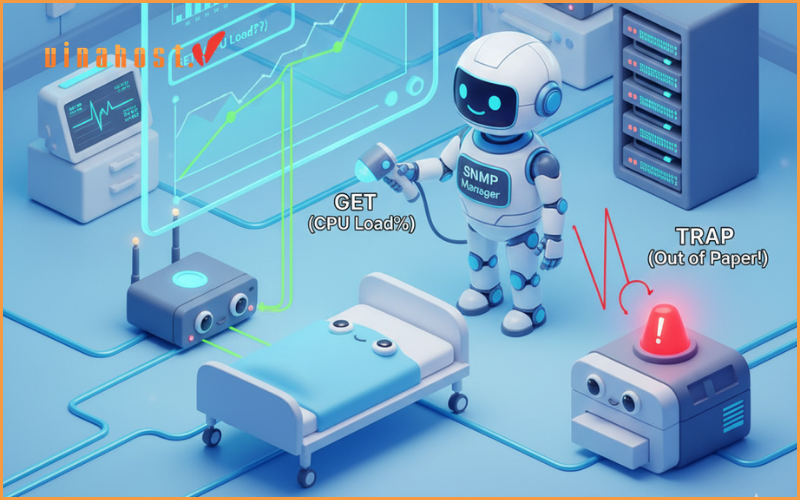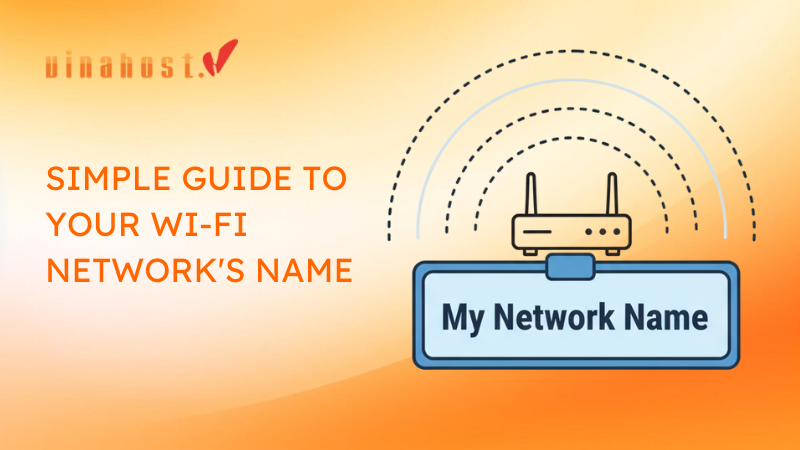What is Registry Lock? Registry Lock is a security feature designed to add an extra layer of protection to your domain name. It prevents unauthorized changes by requiring a thorough authentication process before any modifications can be made. This includes changes to critical domain settings such as DNS configurations, contact information, and domain transfers. By enabling Registry Lock, domain owners can safeguard their domains from hijacking, unauthorized updates, and other forms of cyber threats. VinaHost‘s informative article about Registry Lock is available for your perusal now!
1. What is Registry Lock?
What is domain Registry Lock? Registry Lock is a security feature offered by domain name registries to protect your domain name from unauthorized changes. It’s like adding an extra lock on your domain name to prevent someone else from transferring it, modifying its settings, or even deleting it altogether.
Registry Lock ensures that any changes to the domain are deliberate and authorized, significantly reducing the risk of unauthorized modifications and enhancing the overall security of the domain name.
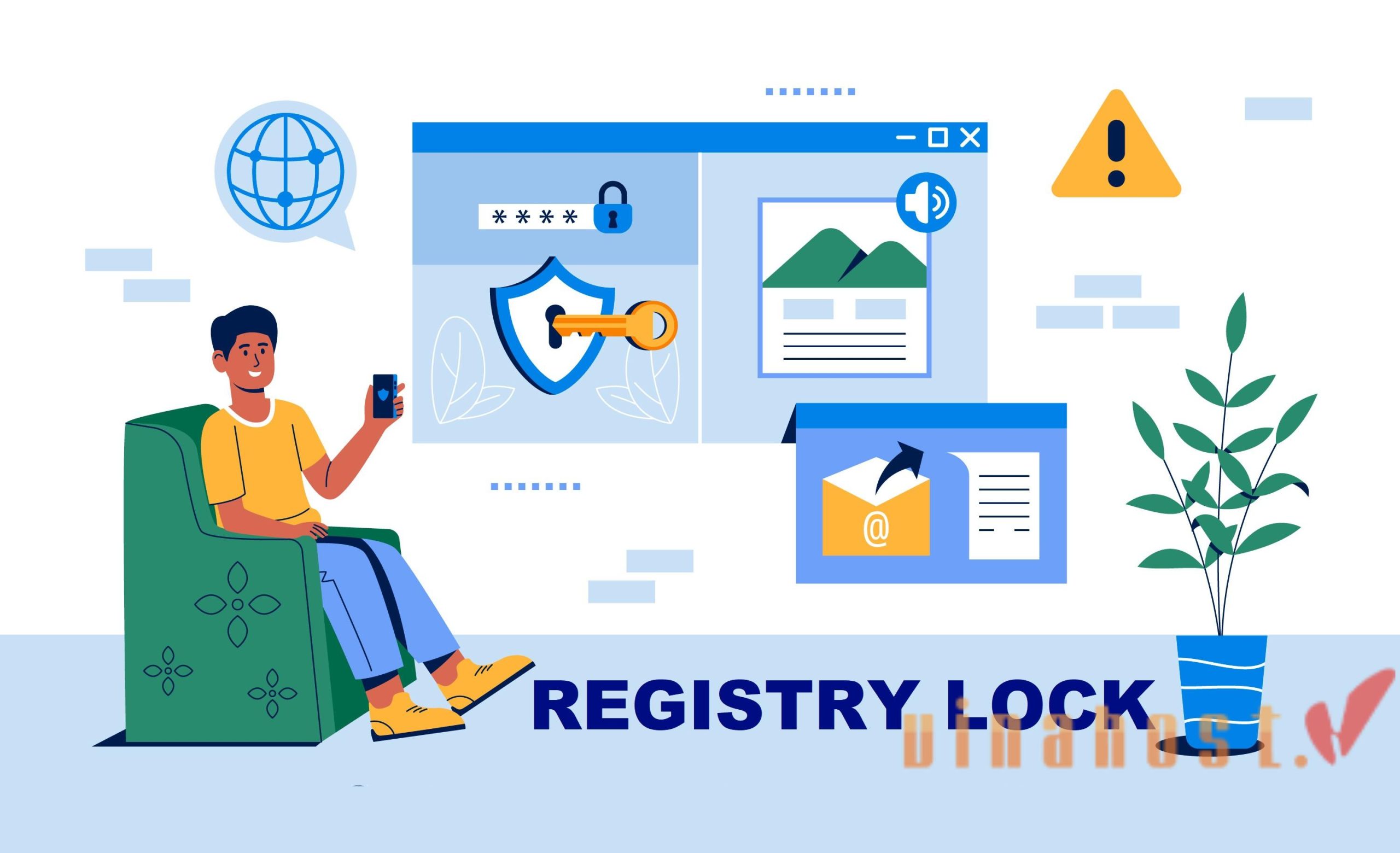
Also Read: What is Domain & How It Impacts Your Online Presence
2. How does Registry Lock work?
Registry Lock works by adding an additional layer of security to the domain name registration process. Here’s how it works:
Initial setup:
- Request activation: The domain owner contacts their domain registrar to request it for their domain. This service is not automatically enabled and usually requires explicit action from the domain owner.
- Verification process: The registrar performs a thorough verification of the domain owner’s identity. This might involve various forms of authentication, such as phone calls, emails, or even in-person verification.
Lock activation:
- Registry and registrar coordination: Once the domain owner is verified, the registrar coordinates with the domain registry (the organization responsible for managing the top-level domain) to enable the lock.
- Locking the domain: The domain is placed in a locked status at the registry level. This status is often referred to as “serverTransferProhibited,” “serverUpdateProhibited,” and “serverDeleteProhibited,” which prevents unauthorized transfers, updates, or deletions.
Making changes:
- Change request: If the domain owner needs to make changes to the domain (such as updating contact information, changing DNS settings, or transferring the domain to another registrar), they must submit a request to the registrar.
- Verification again: The registrar performs another round of strict verification to ensure the request is legitimate and authorized. This can involve multiple forms of authentication and might require approval from designated contacts within the domain owner’s organization.
- Temporary unlock: After successful verification, the registrar temporarily unlocks the domain at the registry level. This allows the requested changes to be made.
- Relocking the domain: Once the changes are completed, the registrar coordinates with the registry to relock the domain, reinstating its protected status.
Ongoing monitoring:
- Alerting and auditing: The registrar and registry often monitor the domain for any unauthorized attempts to change its status. Alerts and audit logs can help detect and respond to suspicious activities promptly.
Also read: What is Domain Privacy? | Do you need Domain Privacy?
3. Why Use Registry Lock?
Using it for your domain provides robust protection against unauthorized changes, including domain hijacking, unauthorized transfers, and malicious modifications to DNS settings.
This security measure is particularly important for high-value domains, ensuring the stability and integrity of your online presence by requiring multi-factor authentication and stringent verification for any changes. By mitigating risks of downtime, business disruption, and reputational damage, Registry Lock is essential for maintaining the security and reliability of critical online assets.
4. The Benefits of Registry Lock

4.1. Enhanced Security
It provides enhanced security for your domain in two main ways: preventing unauthorized changes and accidental deletions. This is how it enhances security:
- Multiple verification steps: When changes are requested for a domain with Registry Lock, the domain owner must pass multiple layers of authentication. This might include passwords, security tokens, one-time passwords (OTPs) sent via SMS or email, and biometric verification.
- Reduced risk of unauthorized access: Even if one form of authentication is compromised, additional verification steps significantly reduce the risk of unauthorized access to the domain.
- Manual confirmation: Changes often require manual confirmation from the domain owner or designated contacts. This can involve phone calls with pre-established passwords, security questions, or even face-to-face verification in some cases.
- Prohibited actions: With Registry Lock enabled, critical domain actions such as transfers, deletions, or updates are set to “serverTransferProhibited,” “serverUpdateProhibited,” and “serverDeleteProhibited.” These statuses mean that changes cannot be made without unlocking the domain, which requires passing the aforementioned verification processes.
- Preventing accidental deletions: Sometimes mistakes happen. With Registry Lock enabled, accidentally deleting your domain becomes much less likely. The verification step acts as a safety net, prompting you to confirm your intention before allowing a permanent deletion. This can be a lifesaver if you accidentally initiate a deletion process.
4.2. Reduced Risk of Fraudulent Transfers
Fraudulent transfers are a sneaky tactic where someone tries to steal your domain name by transferring it to a different registrar without your permission. This can be disastrous, especially for businesses that rely heavily on their online presence. Here’s how Registry Lock specifically helps:
- Enhanced verification: When it is enabled, any request to transfer the domain to another registrar must go through an enhanced verification process. This typically includes multi-factor authentication, such as phone verification, email confirmation, and sometimes even in-person checks.
- Authorization codes: Transfer requests often require special authorization codes that are only accessible to the legitimate domain owner. With Registry Lock, these codes are further protected, ensuring that only authorized personnel can initiate a transfer.
- Registrar and registry coordination: Both the domain registrar (the service provider managing your domain registration) and the domain registry (the entity managing the top-level domain, such as .com or .org) work together to ensure that any transfer requests are legitimate. This adds a layer of oversight and reduces the risk of fraudulent activity.
4.3. Improved Control Over Domain Management
With Registry Lock, domain owners retain strict control over their domain management by implementing robust authentication and verification processes for any changes. Here’s how it empowers you:
- Granular control: Without Registry Lock, anyone with access to your registrar account could potentially make changes to your domain. Registry Lock adds an authorization step, ensuring only you or someone you explicitly approve can modify critical settings.
- Two-step verification: Think of it like requiring two keys to unlock a door. Even if someone gains access to your registrar login (one key), they can’t make changes without the additional verification step triggered by Registry Lock (second key).
- Reduced risk of mistakes by others: If you have multiple people managing your domain (e.g., employees, freelancers), Registry Lock provides an extra layer of security. It prevents accidental or unauthorized changes by others who might have access to your registrar account but shouldn’t have full control over your domain.
4.4. Peace of Mind for Business Owners
For many businesses, their domain name is a cornerstone of their online identity. It’s how customers find them, access their website, and establish trust. Losing control of a domain can be devastating. Here’s a closer look at why Registry Lock provides peace of mind for business owners:
- Reduced distraction and stress: By implementing Registry Lock, business owners can delegate domain management tasks with confidence, knowing that their domain is protected against unauthorized changes. This allows them to focus their time and energy on core business activities rather than worrying about potential security threats.
- Enhanced productivity: With the assurance that their domain is secure, business owners can work more productively without the distraction of constantly monitoring for potential domain-related issues. This enables them to drive growth and innovation within their business with greater peace of mind.
- Preserving brand reputation: A secure domain is essential for maintaining brand reputation and customer trust. By ensuring that their domain is protected against unauthorized changes and transfers, business owners can uphold their brand’s credibility and integrity in the eyes of their customers and stakeholders.
- Enhancing customer confidence: Customers are more likely to trust and engage with businesses that demonstrate a commitment to security and protection of their online assets. Registry Lock provides reassurance to customers that their interactions with the business, conducted through its domain, are secure and reliable.
Also Read: What is Whois? | Everything You Need To Know Whois
5. Limitations of Registry Lock
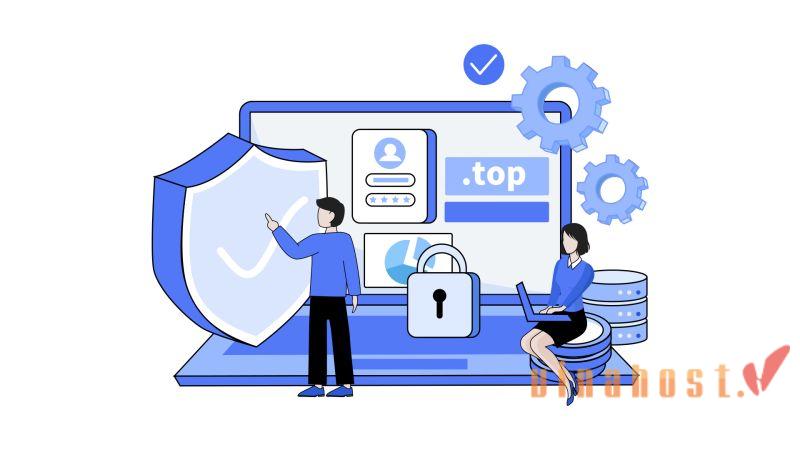
While Registry Lock offers significant security benefits for your domain name, it does come with some limitations to consider:
- Complex implementation: Enabling Registry Lock typically involves coordination between the domain owner, registrar, and registry. The process can be complex and time-consuming, requiring careful planning and communication.
- Potential delays: The enhanced verification processes required for making changes to a locked domain can introduce delays, especially for time-sensitive updates. This can impact the agility of domain management, particularly in urgent situations.
- Limited flexibility: Once Registry Lock is enabled, making changes to the domain becomes more cumbersome. While this is a security feature, it can also restrict the flexibility of domain management, requiring additional steps for even routine updates.
- False sense of security: While Registry Lock provides significant protection against unauthorized changes, it’s not foolproof. Sophisticated attacks, such as social engineering or compromise of authorized credentials, can still circumvent these security measures.
- Cost considerations: Some registrars may charge additional fees for enabling Registry Lock or for each verification process associated with making changes to a locked domain. This can add to the overall cost of domain management.
- Single point of failure: If the authentication mechanisms or verification processes used to manage Registry Lock are compromised, it can potentially lead to unauthorized changes or transfers, undermining the security of the locked domain.
- No protection against all threats: While Registry Lock protects against specific types of threats, such as domain hijacking and unauthorized transfers, it may not address other security risks, such as DNS hijacking, DDoS attacks, or malware infections.
- Limited availability: It may not be offered by all domain registrars or supported for all top-level domains (TLDs). This limits its availability as a security option for some domain owners.
- Difficult recovery process: If the domain owner loses access to their authentication credentials or encounters issues with the verification process, recovering access to the domain and disabling Registry Lock can be challenging and time-consuming.
Weighing the benefits and limitations of it will help you decide if it’s the right security solution for your domain name.
Also read: What is VN domain? | Overview of domain names .VN
6. Alternatives to Registry Lock
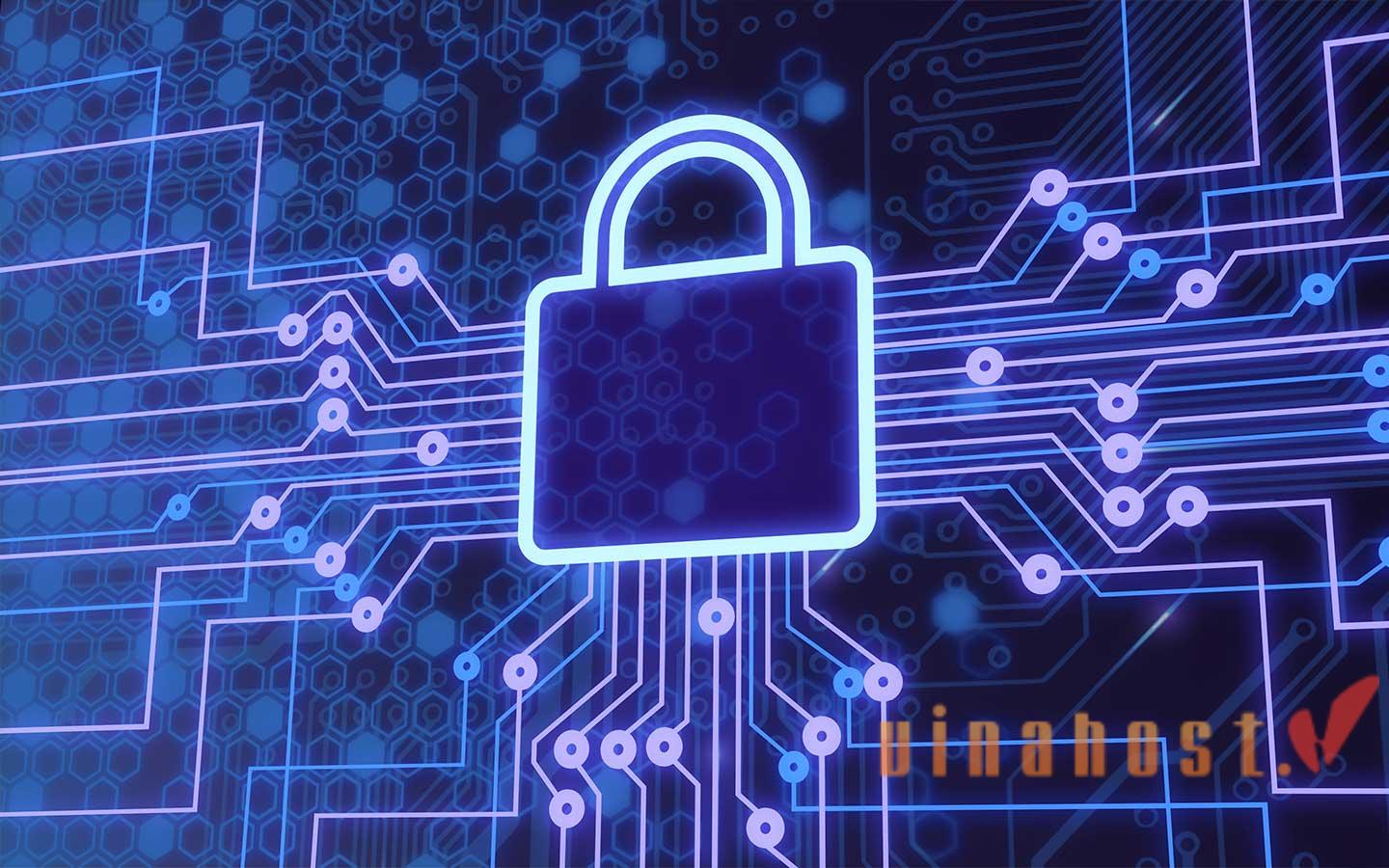
Two-factor authentication adds an extra layer of security to the domain management process by requiring users to provide two forms of verification before accessing their accounts.
This typically involves something the user knows (like a password) and something they have (like a mobile device for receiving authentication codes). Implementing 2FA helps prevent unauthorized access to domain management tools even if passwords are compromised, enhancing overall security.
6.1. Two-Factor Authentication (2FA)
Two-factor authentication adds an extra layer of security to the domain management process by requiring users to provide two forms of verification before accessing their accounts.
This typically involves something the user knows (like a password) and something they have (like a mobile device for receiving authentication codes). Implementing 2FA helps prevent unauthorized access to domain management tools even if passwords are compromised, enhancing overall security.
6.2. Strong Passwords and Password Management
Utilizing strong and unique passwords for domain management accounts is essential for preventing unauthorized access. Employing password management tools can assist in generating and securely storing complex passwords for various accounts.
Additionally, enforcing regular password updates and educating users about best practices for password security can further enhance domain protection.
6.3. Domain Monitoring Services
Domain monitoring services continuously monitor domain registrations, DNS records, and SSL certificate status for any suspicious activity or unauthorized changes.
These services provide real-time alerts and notifications to domain owners, allowing them to respond promptly to any potential security threats. By actively monitoring domain activity, owners can detect and mitigate risks before they escalate into major security incidents.
Besides, you can use 2 common service below to protect your domain privacy:
- DNSSEC (Domain Name System Security Extensions): DNSSEC is a set of extensions to DNS protocols that adds an additional layer of security by digitally signing DNS data. This helps ensure the authenticity and integrity of DNS records, preventing DNS spoofing and cache poisoning attacks. Implementing DNSSEC can enhance the overall security of domain name resolution and mitigate the risk of DNS-related attacks.
- Registrar Lock: Similar to Registry Lock, registrar lock (also known as domain lock) is a feature offered by domain registrars that prevents unauthorized domain transfers. While not as comprehensive as Registry Lock, registrar lock can still provide an additional layer of protection by requiring additional verification steps before a domain can be transferred to another registrar.
Also read: What is VNNIC? | Everything you need to know VNNIC VN
7. The Future of Registry Lock
Registry Lock is expected to remain a valuable tool for domain security in the future.
As technology advances, Registry Lock may integrate with emerging security technologies such as blockchain-based authentication, biometric verification, or advanced encryption methods. These innovations could further enhance the security and resilience of Registry Lock against evolving cyber threats.
Efforts may be made to streamline the implementation and management of Registry Lock, making it more accessible to a wider range of domain owners. This could involve standardized processes, improved user interfaces, and automation of verification procedures to reduce complexity and administrative overhead.
I think that registry Lock may see increased support and adoption across different domain registries and registrars. As awareness of cybersecurity risks grows, more domain owners, particularly those with high-value or mission-critical domains, may choose to enable Registry Lock as a standard security measure.
Future iterations of Registry Lock may incorporate advanced threat detection and response capabilities to proactively identify and mitigate potential security threats, such as DNS hijacking, domain spoofing, or insider attacks, before they escalate into major incidents.
Besides, regulatory frameworks related to domain security and privacy may evolve, driving changes in how Registry Lock is implemented and enforced. Compliance with industry standards and regulations, such as GDPR, CCPA, or industry-specific guidelines, could influence the design and implementation of Registry Lock.
Finally, it will become more tightly integrated with broader security ecosystems, allowing seamless collaboration with other security solutions and threat intelligence platforms to provide comprehensive domain protection against a wide range of cyber threats.
8. FAQs
8.1. Does Registry Lock Cost Extra?

Registry Lock typically comes with an additional cost from domain registrars. The pricing structure may vary depending on the registrar and the specific features included in the Registry Lock service.
- Domain value: For some registrars, the cost of Registry Lock might be tied to the perceived value of your domain name. High-value domains with trademarks or brand names might incur a higher fee for Registry Lock.
- Setup fees: Some registrars may charge a one-time setup fee to enable Registry Lock for a domain. This fee covers the initial configuration and activation of the Registry Lock service.
- Annual subscription: Many registrars offer Registry Lock as a subscription service, requiring an annual fee to maintain the lock on the domain. The subscription fee may vary depending on factors such as the registrar’s pricing model, the number of domains protected, and the level of security features included.
- Additional verification Fees: Certain types of changes to a locked domain, such as unlocking the domain for updates or transfers, may incur additional verification fees. These fees cover the cost of performing enhanced authentication procedures to ensure that the requested changes are legitimate.
While Registry Lock does come with an additional cost, the investment can be worthwhile for businesses and organizations looking to enhance the security of their domain names and protect against unauthorized changes or transfers.
You can refer to VinaHost pricing below:
| SERVICE | PRICE (10% VAT INCLUDED) | REGISTER |
|---|---|---|
| REGISTRY LOCK (FOR DOMAIN .VN) Prevent unauthorized use of domain names | $16.50 / year | Register |
| WHOIS PROTECTION (FOR INTERNATIONAL DOMAIN) Protect private information of domain names | $4.95 / year | Register |
| DNSSEC (FOR INTERNATIONAL DOMAIN) & DNSSEC (FOR VIETNAMESE DOMAIN) Extensive security for the DNS system | $1.10 /year & $2.20 /year | Register |
| .VN Domain Registration REGISTER YOUR .VN DOMAIN NAMES | $1.50 /year | Register |
8.2. Can I Still Update My Domain Settings with Registry Lock Enabled?
Yes, you can still update your domain settings with Registry Lock enabled. However, the process might involve an additional verification step compared to not having Registry Lock.
Initiating changes: When you try to modify your domain settings, like nameservers or contact information, through your domain registrar’s control panel, the process will proceed as usual initially.
Verification triggered: With Registry Lock enabled, the update request is intercepted and a verification process is triggered.
Verification methods: This verification might involve:
- Authorization code: The registrar might send you an authorization code via email or phone that you’ll need to enter to confirm the change.
- Confirmation email: You might receive a confirmation email from your registrar or the domain registry, requiring you to click a link or respond to the email to verify the update.
Approval required: Once you successfully complete the verification step, the update request is sent to the registry for final approval.
Processing and update: Assuming the verification is successful, your domain registrar will process the update and apply the changes to your domain settings.
Also read: What is domain .com.vn? | Overview of domain names .com.vn
8.3. Is Registry Lock necessary for personal domains?
While Registry Lock may not be necessary for all personal domains, it can be a valuable security measure for individuals who prioritize the protection of their domain name and want to prevent the risk of unauthorized access or domain changes.
If your domain name has personal value, like containing your name or a cherished nickname, Registry Lock might be a good idea to prevent accidental deletion or unauthorized transfer.
Even if it’s a personal domain, do you use it for a side hustle or online portfolio? In that case, Registry Lock adds a layer of security for your professional online presence.
Good candidates for Registry Lock:
- Domains with personal value (names, nicknames)
- Domains used for online portfolios or side hustles
- If you’re concerned about phishing or accidental deletion
Registry Lock might not be essential for:
- Domains you rarely use and have minimal value attached
- If you’re comfortable with the existing security measures (strong passwords, 2FA)
- If the verification step for changes seems too inconvenient
8.4. Does Registry Lock work for all domain extensions (e.g., .com, .org)?

Registry Lock may not be available for all domain extensions (also known as top-level domains or TLDs) as it depends on the policies and capabilities of individual domain registries and registrars. While many popular TLDs like .com, .net, and .org support Registry Lock, the availability of this feature can vary depending on the specific TLD and the registrar you use.
- Common TLDs: Registry Lock is typically available for popular generic TLDs (gTLDs) like .com, .net, .org, .info, and .biz. These TLDs are managed by large domain registries that often offer Registry Lock as a security feature to domain owners.
- Country Code TLDs (ccTLDs): The availability of Registry Lock for country code TLDs (ccTLDs) varies depending on the policies of the respective ccTLD registry. Some ccTLDs may offer Registry Lock as an optional security feature, while others may not support it at all.
- New gTLDs: Many newer generic TLDs introduced in recent years (referred to as new gTLDs) also support Registry Lock. However, the availability of this feature may depend on the registry operator managing the specific new gTLD.
- Considerations for International Domains: If you have domains with internationalized domain names (IDNs), which include non-ASCII characters, the availability of Registry Lock may vary. Some IDN TLDs support it, while others may not.
The best way to find out if Registry Lock is available for your domain extension is to check with your domain name registrar. Their website or customer support team can provide details about specific TLD support for it.
Even if Registry Lock isn’t available, maintain strong security practices like using complex passwords with two-factor authentication on your registrar account.
Ultimately, the decision to enable Registry Lock depends on your specific needs and the value you assign to your domain name. For valuable domains or those critical to your online presence, Registry Lock is a highly recommended security measure. It’s a strategic investment that safeguards your digital asset and empowers you to maintain complete control over your online identity.
Also Read: What is .org.vn domain? | Overview of domain names .org.vn
9. Conclusion
Today, your domain name is more than just an address; it’s your online identity. It’s the cornerstone of your website, email, and online presence. Protecting it from unauthorized access and accidental deletion is crucial. Registry Lock can be a powerful security measure to fortify your domain against these threats.
For business owners with mission-critical domains, Registry Lock offers invaluable peace of mind. It safeguards their online brand reputation and prevents disruptions to their website or email functionality. For personal domains with sentimental value, Registry Lock provides a safety net against accidental deletion or unauthorized transfers. We hope this article helps you understand what is Registry Lock and how it works. You can find out more articles at our Blog and don’t hesitate to contact us for support:
- Email: support@vinahost.vn
- Hotline: 1900 6046
- Livechat: https://livechat.vinahost.vn/chat.php
>>> Read more:
What is ICANN? | Why Does ICANN Matter | How It Works
What is .net.vn domain? | Overview of domain names .net.vn


 Tiếng Việt
Tiếng Việt English
English 简体中文
简体中文

















































































